Thursday Jan 30, 2025
Thursday Jan 30, 2025
Thursday, 13 September 2018 00:00 - - {{hitsCtrl.values.hits}}

Expert in International Water Resource Management, Specialist in Water Security and Climate Variability in Sri Lanka, and Until recently, WASH Advisor for ZOA, Sudan Dr. Timotheus Gaasbeek, Research Group Leader for Water Risks and Disasters International Water Management Institute Dr. Giriraj Armarnath, Deputy Director south Asia Center London School of Economist Dr. Nilanjan Sarkar, Senior Researcher (Environment and Development Economics) International Water Management Institute Dr. Soumya Balasubramanya and Deputy Director of Research Department of Agriculture, Sri Lanka Dr. P. B. Dharmasena
Natural resources, such as water, are under extreme pressure in contemporary times. As the effects of global warming and climate variability become more evident, water takes centre stage as an unfolding global crisis. Increasingly, we hear of cities with depleting water supplies, agricultural lands rendered arid by a lack of rainfall, and communities suffering from diseases caused by poor water quality.
Problems are especially acute in South Asia, where this is complicated further by the challenges posed by a lack of options for sustainably managing water, in terms of equitable access or available technology. Dense and increasing (ageing) populations, expanding agricultural sectors, and the pollution of waterways are other issues that South Asia grapples with.
A deep look at the issues around ensuring water security and managing water resources is therefore of critical concern. Governments must consider the critical nature of water when devising development plans and economic and social policies and programs.
For an island nation like Sri Lanka, the prospect of depleting water resources and fresh water availability is especially serious. Already, the country faces numerous challenges related to managing water, such as persistent droughts and changes in rainfall affecting agriculture, coral and sand mining, marine pollution, energy and irrigation demand, groundwater pollution, wastewater management, etc. Water in Sri Lanka is associated with complex management challenges, with nearly 40 statutory bodies responsible for water resources.
The lack of a comprehensive strategy and a coordinated approach could have a severe impact on Sri Lanka and its people, as population and development pressures threaten limited fresh water resources.
Recently the latest instalment of ‘Colombo Development Dialogues,’ a collaborative initiative by the LSE South Asia Centre (LSE-SAC) and the United Nations Development Programme in Sri Lanka - in partnership with Dilmah Tea, Citra Social Innovation Lab, and the Faculty of Graduate Studies - looked at the question of water security in Sri Lanka through its specific problems.
The aim of the discussion, the theme of which was ‘Water Security and Climate Variability,’ was to underline the need to continuously search for newer ways to understand the critical nature of the issue that confronts us all.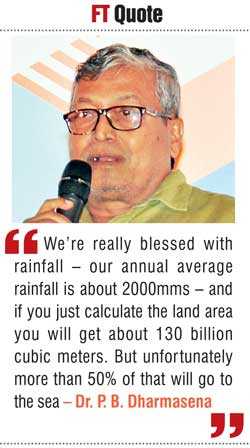
Poor water management
One of the primary problems flagged by a panel of experts in attendance was Sri Lanka’s inefficient utilisation of rainwater. Dr P.B. Dharmasena, Deputy Director of Research Department of Agriculture, points out that in the case of Sri Lanka water resources are abundant – something that may come as a surprise considering the drought affecting several parts of the country – but that the island’s present water management systems retain less than half of the rainfall the country receives annually. A majority of it, he explains, is lost to the ocean.
“We’re really blessed with rainfall – our annual average rainfall is about 2000mms – and if you just calculate the land area you will get about 130 billion cubic meters. But unfortunately more than 50% of that will go to the sea,” he says.
“The question is why can’t we get more and more water within the land without releasing it to the sea? We experience floods intermittently, we experience droughts intermittently, but we have enough water. If we just look at our island, we have 103 river basins of which about 16 river basins are very important and significant as far as the area is concerned, and also the total volume of water is concerned. If we just take them separately, some river are releasing more than 60-70% of its water.”
Of the 103 river basins, 80 major reservoirs and dams, and over 25000 combined minor tanks and anicuts in Sri Lanka, there are large disparities when it comes to effective water retention in some of the biggest rivers in the country.
Take for example the Gin Ganga, Kalu Ganga, and Kelani Ganga, all three of which leak 60-70% of the annual rainfall it receives, while none of the Kala Oya, Malwathu Oya, or Yan Oya leak more than 20%. In fact if you compare the Kalu Ganga which receives over 10,000 cubic metres of rainfall annually with the Walawe Ganga which receives a similar amount, the difference is stark: the former leaks 77% to the ocean on average annually, while the latter just 22%.
This, says Dharmasena, is down to the Government’s ignorance when it comes to the country’s ancient water management systems. Namely, Sri Lanka needs to make better use of its tank cascade ecosystems.
“We can minimise flood and drought if you manage it as far the river basins are concerned. In these river basins if you can have reservoirs in proper locations, not in the upper part of the river basin but in the middle of it that will solve the problem of drought and flood.
“Second, we have a very long history of water management, and it’s not only on the basis of the river basin. Water is diverted from one river basin to the other in order to compensate the deficit of water in one river basin. For example, there are giant canals to divert water from Kala Oya to Malwathu Oya and from Malwathu Oya to Kanagarawa where you get a lot of deficits of water.
“We should not forget that in a lot of areas we have clusters of tanks, tank cascades systems – we have identified about 1,600 tank cascades in the North and North Central, North Western, and Southern Provinces. These tank cascade systems are not only for irrigation, it’s an ecosystem. And these ecosystems should be restored to ensure that the water is available for both the population and the environment.”
To do this however requires effective coordination between water-related agencies in the country, something that is much easier said than done when you consider that there are over 10 ministries overlooking water management in the country, all of which are linked to 28 separate State agencies.
Dharmasena suggests the implementation of an apex body, but one with open channels to engage with all relevant stakeholders. Certain issues, he noted, would only be known to those operating at ground level and that those problems should be addressed at a divisional secretariat level, while the macro issues must be addressed by a national body.
“We should have a coordination body, which is independent of politics, compromising national level, district level and divisional secretariat level committees. The decision making should be allowed both ways - from bottom to top and top to bottom,” he said.
Addressing variability in rainfall and climate
Another key point brought up was the need to acknowledge climate and rainfall variability over prolonged periods. Dr. Timotheus Gaasbeek, an expert in International Water Resource Management, and a specialist in Water Security and Climate Variability in Sri Lanka, noted that since the advent of long-term climate data recordings it has been made clear that Sri Lanka is prone to sustained wet and dry periods.
The issue however, he explains, is that when it comes to that some of the country’s water management systems weren’t built taking into consideration these long-term trends.
“If you look at low rainfall time series for Sri Lanka there are dry and wet periods. Around 1900-1920 it was dry, then it got wet, in the late 1940s it was dry again, it got wet again, and from about 1970-2000 it was dry, and it got wetter again.
“And that’s important because our water demand keeps growing. And after a period where structurally the availability of water has reduced because there is less rain, we have designed things with a much high rainfall in mind – this is where we create a problem for ourselves. The other way around, if we create things with only low rainfall in mind and we get a wet period, we get extra flooding and our systems can’t cope with it.”
According to Gaasbeek, as per this cycle Sri Lanka is now in the midst of wet period, which may come as shock to many considering several parts of the country are undergoing severe drought. This long-term cycle, he believes, is down to a phenomenon taking place as far off as the North Atlantic, which he believes is going to leave Sri Lanka experience a dry period in the near future.
“There’s only one cycle I know that has pretty much the same pattern and that’s the ocean between Greenland and Iceland. When that grows cold, the winds over the Atlantic change and the rain doesn’t go over England, it goes over Scandinavia. The wind then cools down and curls around high pressure areas into Africa, and further into China, and into India. If another period is coming where the North Atlantic cools and this cycle goes into a cold phase, that means Sri Lanka is going to have to deal with less and less rain.”
Parallel to a point made by Dharmasena, Gaasbeek believes that in terms of water management infrastructure in the country, what is already in place might not necessarily have the upcoming change in cycle. This he notes as already had dire consequences for the country in terms of water management over recent decades.
“A lot of our recent irrigation schemes were built in the ’70s, with rainfall data from the 1930s onwards, which was a wet period. Straight after the systems were built the rainfall reduced and suddenly things didn’t work as they were supposed to because we didn’t have the rain that we were supposed to have.
“It partially recovered but it might happen again. It will influence food production in Sri Lanka and that means, structurally for a period of time Sri Lanka will need to find a way to manage its agricultural economy, its water economy.”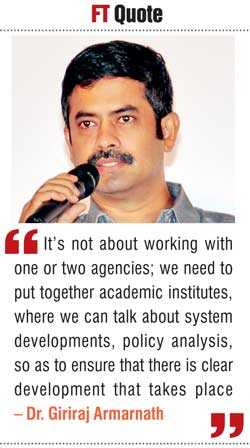
Possible structural connotations
One other point Gaasbeek brought up surrounded changing rainfall patterns in Sri Lanka’s hill country, which he points out has been declining consistently, and has in turn resulted in increasing trouble for tea estates. In this same period, Colombo has gotten much wetter.
Gaasbeek posits this could be down to man-made changes, such as shifts in land use and increased deforestation.
“For some reason during the South West monsoon the water that used to fall in Nuwara Eliya is falling here [in Colombo]. The clouds form earlier, the rain falls earlier, and by the time it reaches Nuwara Eliya there’s not so much rain anymore.
“I have a hunch, but it’s only a hunch, that it might have to do with changes in land use. Over the last 150 years the hill country has changed dramatically, from a lot of forest to a combination of plantations, towns, villages, and fields. And they react completely differently in terms of evaporation, and in terms of cooling the air.”
While he is unable to say with certainty that this is in fact the cause for changes in rainfall seen in the hill country, Gaasbeek urges the relevant stakeholders to take time and investigate any possible correlation between rainfall and changes in land use.
‘Because if there is a correlation,” says Gaasbeek. “Then it also means there is something we can do to address it and bring the rain back to tea.”
Gender inclusiveness
An oft-overlooked aspect of water resource management, is how water security means different things to men and women. Addressing this issue was the key tenet of Dr. Soumya Balasubramanya’s presentation.
As a Senior Researcher (Environment and Development Economics) at the International Water Management Institute, Balasubramanya has used economic methods to address environmental and development challenges in Asia and Africa, and through has identified several issues in relation to gender inclusivity in solving this problem of effective water management.
Gender inclusiveness, she explains, is essential for water security, and gathering data and facts is a vital aspect of designing policies and programs that improve equity along gender lines. The first step in achieving this is through the collection of “better data” so as to tackle myths and support evidence-based policymaking.
“How many men and women spend their time in different economic sectors is likely to change as the pressures change themselves,” she notes. “It’s particularly important to collect time-series data because the roles of men and women can, and often do, change over time.
“The Department of Census and Statistics of the Sri Lanka does a very good job actually of collecting gender delineated data for various economic sectors.”
Looking through the data from the census department, Balasubramanya found that “about 33% of women are employed in agriculture and about 40-50% of the agricultural workforce is itself female”. A staggering statistic that puts forth irrefutable proof that the average Sri Lankan farmer is female, despite many people’s inclination to picture men when it comes to agriculture and irrigation.
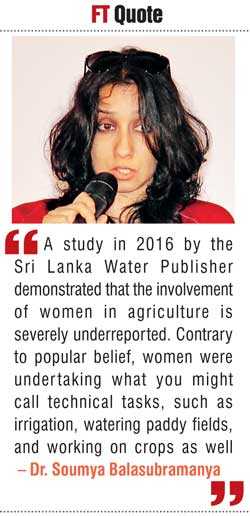
“A study in 2016 by the Sri Lanka Water Publisher demonstrated that the involvement of women in agriculture is severely underreported. Contrary to popular belief women were undertaking what you might call technical tasks, such as irrigation, watering paddy fields, and working on crops as well.”
Furthermore, Balasubramanya points out how patters of migration in Sri Lanka have changed in recent times, with males more likely to migrate now rather than female. This, she explains, has significant implications in the designing of programs in the agricultural sector and in community based water management programs.
“You’re going to have to invest directly to increase the capacities and capabilities of women. Because traditional agricultural extension programs relied on training men, who in turn trained women.
“But that doesn’t necessarily always work because we know information does not diffuse neutrally along gender lines. Men are more likely to talk to men, women are more likely to talk to women.
“It also means changing how you design training programs, you may have to train in villages rather than getting the trainees to come, you may have to design child care facilities.
“If men are not going to be around it really calls for a change in who we train and how we train them.”
Resilient solutions
Up until now, each of the speakers had spoken of the problems at hand and the need for solutions. None however had put forward ideas on how exactly Sri Lanka could go about implementing or achieving those solutions. Dr. Giriraj Armarnath, Research Group Leader for Water Risks and Disasters International Water Management Institute, believes he has some of the answers.
Drawing on his work in other parts of South Asia, Armarnath is major proponent of utilising technology and data-driven systems when formulating effective and resilient solutions. According to his bio his expertise lies in “the monitoring of floods and droughts, rapid emergency response mapping, remote sensing data and image processing, geographical information systems, satellite-based rainfall estimates, drought forecasting, hydrological modelling, flood forecasting and inundation modelling, weather-index insurance, food security, agricultural water management, climate change, and disaster risk management”.
And his work has seen real-world results in places like India, Bangladesh and Thailand, where flooding is a recurring problem.
“We built sub-surface solutions in India, Bangladesh and Thailand. What this means is that when there are excess flood waters coming, we divert that water along several ponds in the irrigation system or rain-flood system, and this water can then be used in the dry season when there is a situation like a drought happening,” he explains.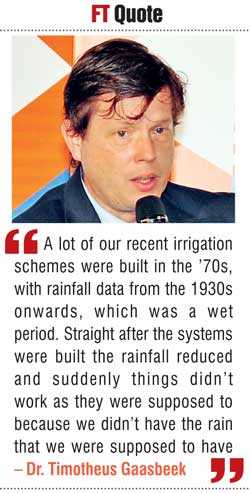
“The Government of India is already investing a huge developmental scale of this project in Uttar Pradesh, in places where we have potential to catch flood water over 22%. 22% is quite a lot when we talk about managing the water.”
A similar project is in fact being initiated by the Asian Development Bank, which is working with Sri Lanka to deliver surplus water from the Mahaweli river basin to the dry zone region – an area in which 70% of rural dwellers depend on agriculture for their livelihoods. The program is building or upgrading more than 260 km of canals, reservoirs and other irrigation infrastructure to deliver water to areas suffering from regular water scarcity and drought.
For Armarnath, this is a step in the right direction, but he strongly stresses that more needs to be done, and that integrated urban water management are the need of the hour.
“It’s not about working with one or two agencies; we need to put together academic institutes, where we can talk about system developments, policy analysis, so as to ensure that there is clear development that takes place.
“We’re talking about human wellbeing on the water quality, we’re talking about ecosystems, we also need to talk about the economic development. That’s what water security is all about. Around that you talk about financing, government, political agenda. It’s not about just setting up some flood models or diverting some of the water.
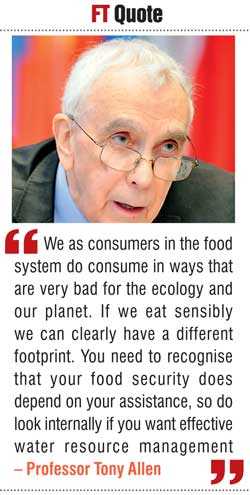 “Water security has a big role to play in Sri Lanka and I think the Government has taken the right step when we talk about these mega projects.”
“Water security has a big role to play in Sri Lanka and I think the Government has taken the right step when we talk about these mega projects.”
Virtual water
While Government oversight in water resource management is undoubtedly critical, it is not the only facet of improving water security. As highlighted by the populace of Cape Town, South Africa, sometimes the most effective method is found by looking inward.
South Africa’s largest city was due to run out of water by August this year, but having realised the extent of the problem a year earlier, the Government raised awareness by announcing a ‘day zero’ – a point at which taps would run dry. This shocked the population into action, and through a several measures such reusing shower water, limiting toilet flushing and night-time irrigation, Africa’s second city was saved from running dry.
While such extreme measures are not needed yet in Sri Lanka, it’s never too late to begin paying attention to your water footprint. This is where the idea of virtual water – sometimes referred to as food water or invisible water – comes in, a concept which looks to raise awareness on the hidden cost of water in everyday life.
“Food water is water needed to produce food. About 92% of the water we consume is food water. The remaining 8% is for industry and domestic use. That is of course a global figure which will vary from country to country,” explains Professor Tony Allen, Emeritus Professor Department of Geography at King’s College London.Allen was named the 2008 Stockholm Water Prize Laureate, having pioneered the development of key concepts in the understanding and communication of water issues and how they are linked to agriculture – ‘virtual water’, climate change, economics and politics.
He too advocates the need for individuals to realise their own water footprints, without solely depending on the Government. Be it eating less meat, or possibly buying smartphones less frequently – a single smartphone takes roughly 13 tons of water to produce – we can all do our part.
“If you’re vegetarian you need about 2,500 cubic metres of water a day, if you’re a heavy meat eater you need 5,000. We as consumers in the food system do consume in ways that are very bad for the ecology and our planet. If we eat sensibly we can clearly have a different footprint. You need to recognise that your food security does depend on your assistance, so do look internally if you want effective water resource management.”
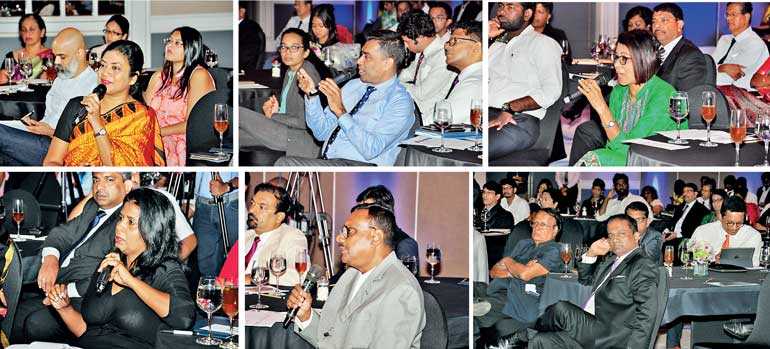
Pix by Sameera Wijesinghe